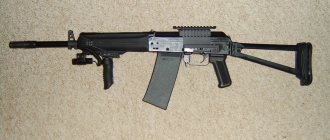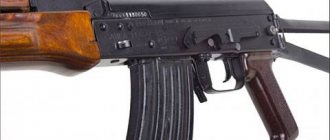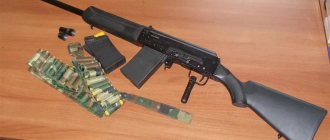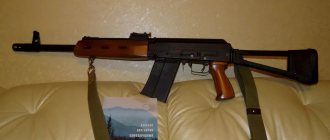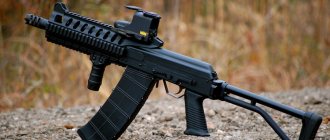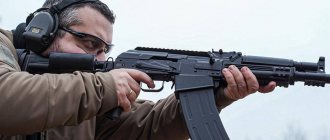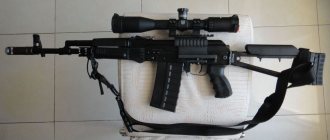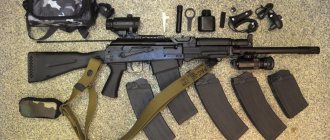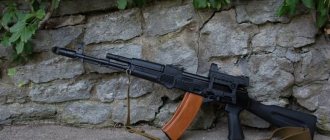[edit] Characteristics
| Parameters/Modification | Saiga-12 | Saiga-12S | Saiga-12K |
| Barrel length, mm | 580/680 | 580/680 | 430 |
| Overall length with the butt folded down, mm | 1145 | 1060 | 910 |
| Overall length with stock folded, mm | 820 | 670 | |
| Weight without magazine, kg | 3,8 | 3,6 | 3,5 |
| Magazine capacity, cartridges | 2, 5, 8 | 2, 5, 8 | 2, 5, 8 |
| Trigger force, kgf | 1,5-3,7 | 1,5-3,7 | 1,5-3,7 |
| Barrel choke constriction with choke, mm | 1,0 | 1,0 | 1,0 |
| Choke constrictions for barrels without a choke constriction | 0; 0,5; 1,0 | 0; 0,5; 1,0 | 0; 0,5; 1,0 |
| Shot accuracy at 35 m, with a muzzle constriction of 1.0, not less, % | 60 | 60 | 60 |
| Shot accuracy at 35 m, without choke, not less than, % | 40 | 40 | 40 |
[edit] Ammunition and shooting performance
Ammunition and shooting performance. One of the achievements of this model was its versatility and performance when using various types of ammunition. During factory testing. Saiga-12 worked flawlessly on all types of cartridges: shot and bullet, with folder, plastic and metal casings. At the same time, during the tests, a variety of cartridges were loaded into the magazine in a random order, differing from each other in the length of the cartridge case (70, 73 and 76 mm), with different weights of both gunpowder and shot charge. Charges with lead bullets such as Polev (Russia), Brenneke (Germany) and experimental brass sub-caliber bullets were also subjected to separate tests.
"Saiga-12K" - Queen of self-defense
It is no secret that the vast majority of our fellow citizens, when purchasing the first smoothbore gun in their lives, define self-defense as its main task. With all the wealth of choice on the smoothbore shotgun market, many choose the Saiga-12K. What is this connected with and what is the essence of the phenomenon, which someone aptly called the “Saiga phenomenon”? In this article, we decided to deviate somewhat from the usual form of tests that are published in our journal.
A little history
The rifled Saiga was a product of conversion, which became an urgent need as a result of reforms in the early 90s of the last century. Unfortunately, the market for rifled weapons is still quite limited (due to legal restrictions), and even more so at that time. Therefore, there was a need to develop a smoothbore modification that was more accessible to a wide range of citizens.
The first smooth-bore Saigas appeared in 1993-94. were .410 caliber. Without a doubt, it has the right to life (as has been proven by the entire subsequent history of this weapon), but still I wanted to have something more significant in my arsenal. In those years, .410-caliber cartridges were in short supply, the domestic industry practically did not produce them, and imports were extremely expensive.
After some time, namely, in 1995, Saiga-20 was released, which gave many people confidence in the appearance of Saiga in the most popular 12-gauge. The earth was full of rumors and, finally, in 1997, Saiga-12 was introduced to the people. This model has gone through the same evolution as its brothers - Saiga-410 and Saiga-20. At first it was an option with a long barrel and a hunting stock. A little later, the stock was made folding and a pistol grip was introduced. Finally, “at the request of the workers,” the barrel was shortened to 430 mm, which required the introduction of a special trigger lock with the butt folded. Indeed, in this position, “Saiga-12K” had a length of less than 800 mm specified in the Law. This is how the appearance of the first generation Saiga-12K was formed.
"Saiga-12K" had several versions. The simplest modifications had rifle-type sights and a choke-type barrel drilling. The next level was “Saiga-12 K RPP” with an adjustable aiming bar. And finally, the top model “Saiga” was offered, in addition to the RPP, with interchangeable choke tubes, and the barrel had a conventional “cylinder” type drilling.
The result is an excellent tactical gun: short, fast-firing and powerful. This was immediately appreciated by the public - we can say that since 1998, Saiga-12K has become a bestseller in the Russian Federation. This was facilitated by a very reasonable price ($200-300 depending on the configuration). The August crisis of 1998 led to a paradoxical phenomenon - imported pump-action guns, which suddenly became expensive, stopped competing with Saiga and made it the “queen” of guns for self-defense.
Selection and design features
The beginning of our acquaintance with this gun goes back to those distant years when there was no CALIBR magazine and the authors of this article were looking for like-minded people for joint training with the then new domestic gun. As a result, these quests resulted in the Moscow Saiga club created in 1999, which is still functioning today.
Based on “self-defense” and “entertainment” tasks, let’s take a closer look at different Saigas. Among the large number of modifications, it seems to us that the Saiga-12K is best suited for this role: short barrel, folding stock. The presence of a side rail for attaching a sight is critical (in the first releases there was none on the short Saiga). Of course, it is not needed to install magnified optics, but a collimator sight (at least in theory) could be useful, especially in competitions. Without a side mount this could be a problem.
A few words about replaceable chokes. Their presence on the short-barreled Saiga seems unnecessary. Moreover, the attachments increased the final cost of the gun by almost 20%! Of course, in this case, firing caliber bullets is excluded, but very few of them are currently produced.
It is better to take a Saiga with an aiming bar. Strictly speaking, such a short sighting line is not entirely convenient, but rifle-type sights for weapons intended for short-range shooting are less convenient. The difference in price between a regular Saiga and a modification with RPP is only 300 rubles, which is quite reasonable.
The only element that needs replacing is the pistol grip. This can be done at home by purchasing a new style pistol grip in the store, which has significantly better ergonomics in contrast to the standard one. It will cost only 170 rubles.
Now let's talk about the problem of choosing a specific instance. First of all, you need to look at the weapon's passport. The shot dispersion must be at least 40%. The barrel must be cleaned of oil and carefully examined under the light for scratches, chips, cracks, which must be done by slowly rotating the gun.
Next, check the roundness and straightness of the barrel: to do this, you need to insert an unprimed cartridge case (ask in the store) into the chamber and look through the barrel at the light: move the gun until the rings appear. The rings should be smooth and round and run concentrically relative to each other.
Inspect the chamber: for convenience, fold the butt (remembering to first raise the safety lever), the rim of the transition of the chamber into the barrel should also be uniform. The muzzle of the barrel must be smooth, without traces of impacts, etc.
The next most important component is the gas exhaust system. It is a chamber into which powder gases are discharged through four transverse holes in the barrel. This chamber contains a piston, which, unlike the “male”, is a separate part from the bolt frame, and can move inside the chamber without going beyond its limits, between the restrictive wall on one side and the gas regulator on the other. The “piston” of the bolt frame is not actually such, but serves only as a pusher of the frame when firing and a pusher of the gas piston during the return stroke. This mechanical decoupling makes it possible to protect the shooter in case of excessive pressure in the chamber, since the bolt frame moves back due to inertia, and not as a result of direct gas pressure on it. Moreover, to relieve excess pressure, a hole was made in the side wall of the chamber leading under the forend, where the gases that escaped under the piston are diverted. The gas regulator allows you to change the volume of gases entering the chamber per unit of time and has two fixed positions: “1” for high-power cartridges (magnum) and “2” for normal-power cartridges (in the figure, the regulator is in position “2”). The design of the regulator does not prevent the passage of gases into the chamber, so they cannot “turn off” the automation. The gas outlet unit also serves for attaching a bolt (M5 standard) to the forend and front swivel, as well as a place for attaching the front sight (M4 standard).
Many shooters recommend immediately setting the gas regulator to position 1 (“magnum”), where the operation of the moving parts of the automatic when using conventional cartridges will have the lowest speed. If in this position your Saiga continues to fire conventional cartridges, then you can achieve two positive consequences at once. Firstly, you will increase the life of the gun, and secondly, the recoil will become less sharp.
It must be said that, based on operating experience, Saiga-12 works on almost all brands of cartridges known in Russia.
When choosing, you need to disassemble the gas system (first remove the bolt frame), unscrew the regulator, inspect the regulator itself (thread) and the piston. You can remove the piston with a cleaning rod, carefully pushing it out from the breech side of the tube (provided that the bolt frame is removed). Inspect the chamber and guide tube “through and through” for rust and quality of processing.
Gate. The bolt carrier with the bolt is structurally similar to similar parts of the AK and has no special differences.
When choosing, pay special attention to the bolt lugs; there should be no cracks or “strange” chips. You should also carefully inspect the lugs of the receiver: there should be no cracks or chips. The frame with the shutter should move freely to the end and, when released, return completely to the stop.
"Saiga-12": Powergrade!
The first generation “Saygists” saw this gun as fertile ground for tuning. Everyone “mocked” the gun due to their own concepts of goodness and beauty. It could also be a banal “attachment” of the Saiga with additional accessories (laser laser, collimators, front sights, flame arresters). Some approached tuning more thoroughly: the plastic parts of the fore-end and handle were replaced with wooden ones, the buttstock was replaced with a metal frame. We have seen much more thorough modifications. In particular, one of the Saigas had a neck welded to the window for inserting a magazine.
The plant closely monitors this kind of experience and introduces some of these innovations into production.
Five years of experience in operating the Saiga-12K led to a rethinking of some elements of the gun. This resulted in a significant modernization of the system, which can be called “Saiga-II”. The first “swallow” was “Saiga-12K Tactics”, shown in February of this year. First of all, a forced shutter lag has appeared, which makes charging easier. The buttstock received a leather butt pad, which increased the ease of working with the gun, especially for tall people. Other delights, such as wooden parts, a muzzle compensator and a high front sight, belong to the so-called “facelift”, that is, refreshing the appearance of the model. This happens very often in the automotive industry.
A deeper modernization of Saiga is being prepared on the basis of the export Saiga-12C-EXP-01. The main novelty of this model is that the push-button fuse instead of the classic flag safety device is really convenient. Just like the Tactics, it has a forced shutter release button. The rubber shock absorber is integrated into the butt, the handle has a more comfortable “pear-shaped” shape. Development of an automatic shutter stop is underway.
And now about what is not, but could be. Firstly, the Saiga’s handguard has long been asking for a Picatinny rail. It’s no secret that they try to hang this gun, like a Christmas tree, with laser sights, tactical flashlights, bipods, etc. The simplest and most affordable option is a standard mount. Similar rails are used both in military weapons and in airsoft pneumatics. By the way, you can also get special handles for the forend for the Picatinny rail from there.
Another crazy idea is a drum magazine. The fact is that the standard five-charger, which is included in the kit, is perceived by many as insufficiently capacious, despite its compactness. The eight-round magazine that appeared later (not to mention the homemade American ten-round magazine) looks very uncompact. What remains is a fundamentally different technological solution - to develop a ten-round drum magazine. There are several positive aspects: the appearance, which has something in common with either the PPSh or the Thompson, increased firepower. The only thing stopping us is the difficulty of making such a device. In principle, the cunning Americans have already adapted 10- and even 25-round drum magazines from the South Korean tactical shotgun Daewoo USAS to their Saiga-12. Such a store costs no more or less than the Saiga in its basic configuration - $200. In the same States, drum magazines are produced for conventional pump-action pumps (for example, by Knoxx, see KALIBR.RU, September 2002).
conclusions
The Saiga shotgun is one of the most reliable and proven designs on the domestic arms market. This is appreciated by buyers - probably the majority of the market for domestically produced smooth-bore weapons is accounted for by this gun.
And abroad, where people have a much larger choice of weapons, in recent years they have become increasingly interested in Izhevsk guns. It is no coincidence that in the most shooting country in the world, the USA, Saiga has received recognition. One of the most famous weapons magazines, Guns and ammo, in the late 90s of the twentieth century, recognized the Saiga-12 as one of the guns of the year.
But let's return to the subject of our conversation today. Without a doubt, the Saiga-12K is currently the best choice of smoothbore shotgun for self-defense. Easy to use and maintain, reliable and unpretentious, using almost any cartridge, it has good maneuverability (due to the short barrel and folding butt) and enormous firepower, which surpasses some submachine guns at close ranges.
Nikolay Dergachev Alexander Kudryashov
